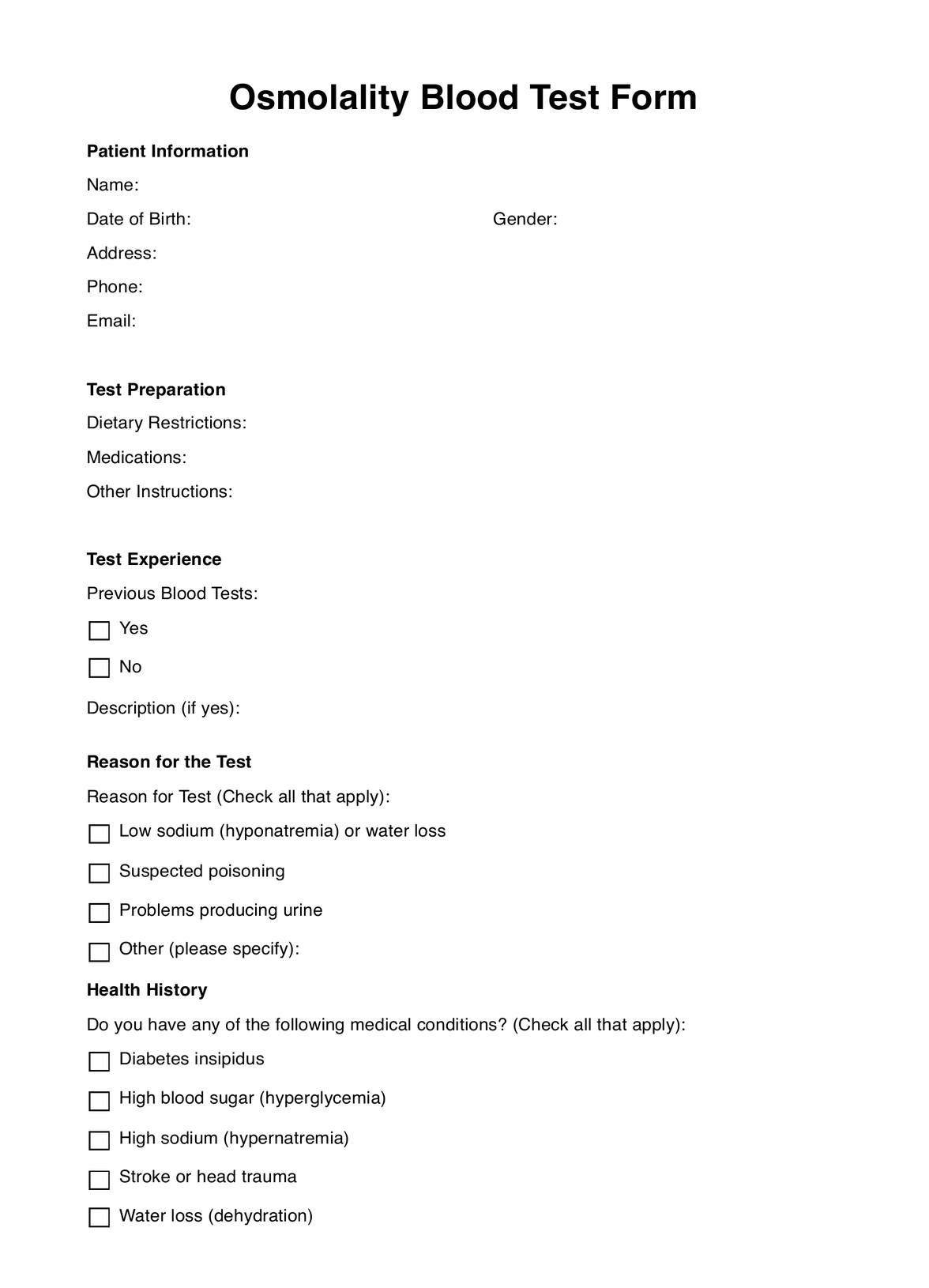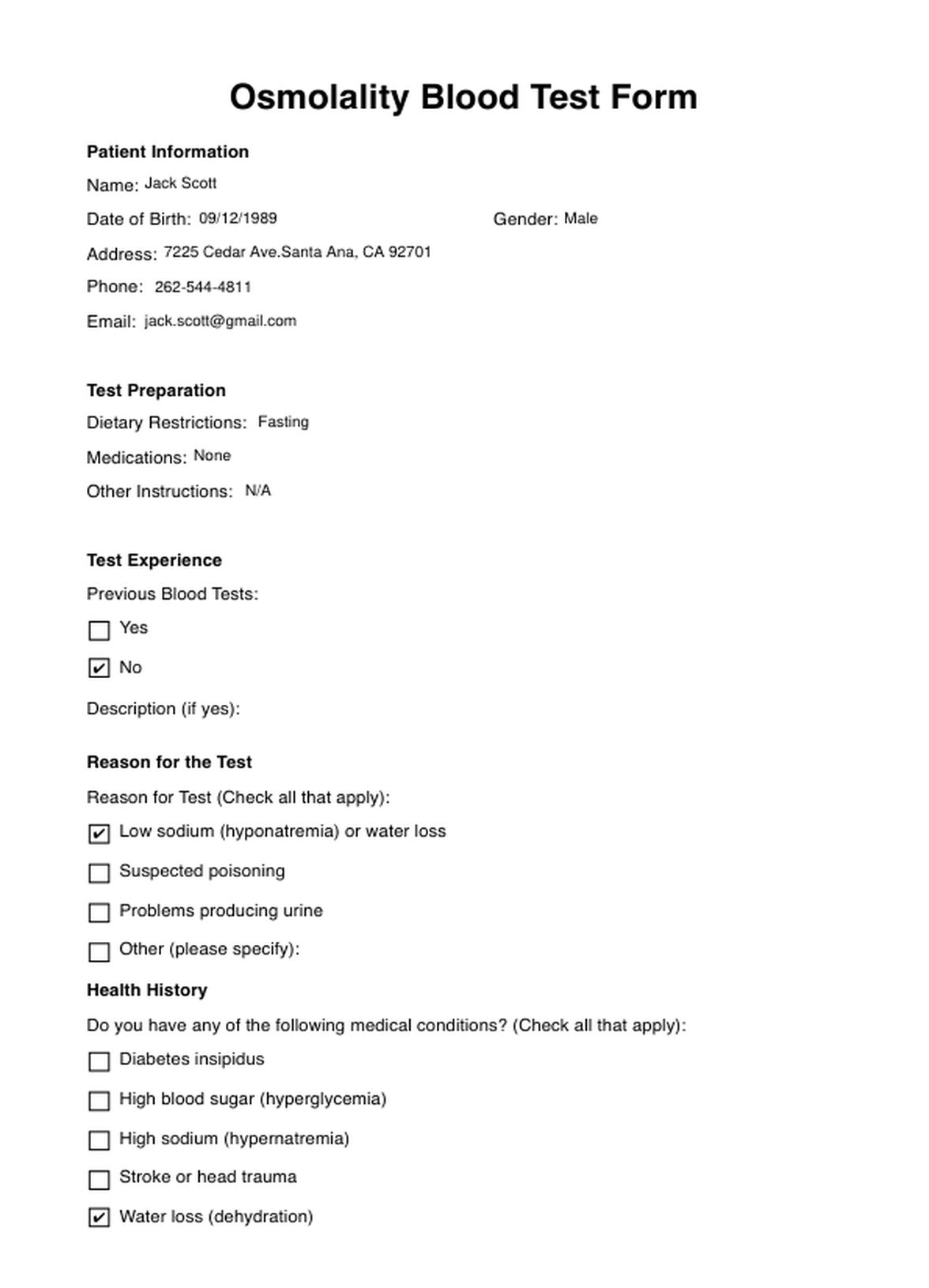Osmolality Blood
Get the Osmolality Blood Test form –simplify patient data collection. Free PDF download is available to ensure efficient diagnostics.


What Is An Osmolality Blood Test?
Osmolality Blood Tests are crucial diagnostic tools that measure the concentration of solutes, or chemical particles, in the fluid portion of your blood. This test is invaluable for assessing your body's water balance and ability to regulate the concentration of solutes in your bloodstream.
A blood sample is typically collected through a simple blood draw during the test. In some cases, osmolality can also be measured using a urine sample.
The osmolality of your blood reflects the balance between water and solutes in your body. When the blood osmolality deviates from the normal range (275 to 295 mOsm/kg), it may indicate an underlying medical condition.
This test is vital in diagnosing and managing various conditions, such as low sodium (hyponatremia), water loss, and disorders like diabetes insipidus. It can also detect poisoning from harmful substances like ethanol or methanol. In normal bodily function, high osmolality triggers the release of antidiuretic hormone (ADH), encouraging the kidneys to reabsorb water and produce more concentrated urine. Abnormal osmolality levels can disrupt this equilibrium, making the Osmolality Blood Test a valuable tool for diagnosing and monitoring several medical conditions related to fluid balance.
Osmolality Blood Template
Osmolality Blood Example
How Does it Work?
Step 1: Introduce the Form
Provide the patient with a copy of the Printable Osmolality Blood Test Form. Greet them warmly and explain the purpose of the form, which is to collect vital information before conducting the Osmolality Blood Test.
Step 2: Assist with Filling
Offer assistance as needed. Some patients may require clarification or help filling out the form, particularly regarding medical history, emergency contact details, and understanding the test's purpose. Ensure all sections are completed legibly.
Step 3: Review Dietary and Medication Instructions
Go over the dietary and medication sections of the form to confirm that the patient has adhered to any specific pre-test requirements as advised by their healthcare provider. Address any concerns or questions they may have regarding these instructions.
Step 4: Confirm the Test Reason
Double-check the patient's reasons for undergoing the test and any specific medical conditions they have mentioned. This step ensures the test aligns with their healthcare needs.
Step 5: Verify Emergency Contact
Ensure the provided emergency contact information is accurate and up to date. This is crucial for patient safety, as it allows for immediate communication in case of unforeseen complications.
Step 6: Obtain Patient's Consent
Request the patient's signature on the form to confirm their understanding and agreement to undergo the Osmolality Blood Test. Also, collect the date of the patient's signature for documentation purposes.
When Would You Use This Test?
Healthcare practitioners and medical professionals will find the Osmolality Blood Test Form invaluable in several key scenarios.
It is vital when assessing patients with suspected electrolyte imbalances or fluid-related issues. Physicians often employ this test when patients present with symptoms of altered water balance, such as excessive thirst, changes in urine production, or confusion.
Also, it is crucial when dealing with cases of potential poisoning. Toxic substances like ethanol, methanol, or ethylene glycol can severely impact the body's osmolality and endanger patient health. In such emergencies, having access to a structured form that streamlines patient data collection is essential for quick diagnosis and treatment.
This form simplifies monitoring osmolality levels over time for patients with underlying medical conditions. This includes adrenal gland disorders, thyroid issues, or inappropriate antidiuretic hormone production syndrome. Routine use of this form allows healthcare practitioners to maintain comprehensive records for better-informed decision-making.
What do the Results Mean?
Interpreting the results of the Osmolality Blood Test is crucial for healthcare providers, as it provides valuable insights into a patient's fluid and electrolyte balance. The normal range for blood osmolality typically falls between 275 to 295 mOsm/kg. Results within this range indicate a healthy equilibrium between water and solutes in the blood.
Elevated blood osmolality, higher than the normal range, may signify conditions like hypernatremia (high sodium levels), hyperglycemia (high blood sugar), dehydration, or ingesting toxic substances. In such cases, prompt medical attention must address the underlying issue and restore balance.
Conversely, lower than normal blood osmolality may indicate conditions like hyponatremia (low sodium levels), syndrome of inappropriate antidiuretic hormone production (SIADH), overhydration, or adrenal gland dysfunction. Low osmolality can lead to water retention and electrolyte imbalances, warranting thorough evaluation and treatment.
It's essential to note that individual patient cases may vary, and the test context, including the patient's medical history and symptoms, plays a significant role in result interpretation. Therefore, healthcare providers should consider all relevant factors when determining the significance of Osmolality Blood Test results.
Test results should be interpreted based on the patient's clinical context, history, and specific symptoms, ensuring the most accurate assessment and care. Consider a free Osmolality Blood Test today to better understand your patient's health.
Research & Evidence
The Osmolality Blood Test, a fundamental diagnostic tool in clinical medicine, has a well-established history rooted in the study of osmolality and fluid balance. The concept of osmolality, which denotes the concentration of solutes in bodily fluids, has interested medical practitioners for over a century. Early attempts to measure osmolality were based on labor-intensive techniques, such as freezing point depression.
Supporting research has come from multiple sources, including studies published in medical textbooks and journals. A foundational source is "Henry's Clinical Diagnosis and Management by Laboratory Methods," which provides insights into evaluating renal function, water, electrolytes, and acid-base balance.
The comprehensive reference "Brenner and Rector's The Kidney" further delves into disorders of water balance, offering valuable insights into the clinical significance of osmolality measurements.
References
McPherson RA, Pincus MR, eds. "Henry's Clinical Diagnosis and Management by Laboratory Methods." 23rd ed. St Louis, MO: Elsevier; 2017.
Yu ASL, Chertow GM, Luyckx VA, Marsden PA, Skorecki K, Taal MW, eds. "Brenner and Rector's The Kidney." 11th ed. Philadelphia, PA: Elsevier; 2020.
Commonly asked questions
These tests are typically requested by healthcare providers, including doctors, nephrologists, endocrinologists, and emergency room physicians.
These are used when there are concerns about a patient's fluid and electrolyte balance, such as suspected electrolyte imbalances, dehydration, poisoning, or certain medical conditions.
It involves drawing a blood sample, which is then analyzed in a laboratory to measure the concentration of solutes in the blood.
The blood draw for an Osmolality Blood Test is relatively quick, usually taking a few minutes. However, the total time for results can vary depending on the lab's workload and specific testing methods, typically ranging from a few hours to a day or more.











































































































